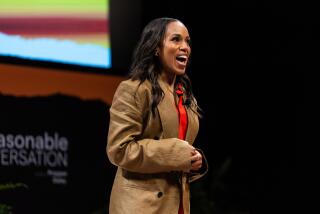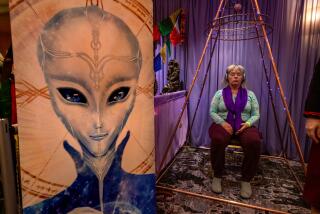TED confab is speaking to the masses -- and drawing scorn
The email that could change Meg Jayâs life came in December without warning, containing little more than a link.
Clicking on it opened a Web page that offered Jay the most significant invitation of her career: âWeâre honored to have this opportunity to invite you to give a talk at TED.â
Without hesitation, she accepted. And just like that, the Virginia clinical psychologist, who specializes in âtwentysomethings,â or the study of people in their 20s, was swept into the slipstream of a cultural juggernaut that has expanded well beyond its original focus on technology, entertainment and design.
If her talk at the five-day TED conference goes as planned, Jay could be catapulted into an international celebrity achieved by few academics or scientists.
âI think everyone knows having a TED talk is great for your message,â Jay said. âOf course, itâs also a little bit of pressure.â
Such is the sway of TED, which began its fifth and final annual conference in Long Beach on Monday. During that stretch this once obscure gathering of engineers, theorists and artists has exploded in reach and influence.
âTED is like the Oscars of speaking,â said Nilofer Merchant, a Silicon Valley corporate strategist speaking this year on the topic âSitting is the Smoking of Our Generation.â Merchant explains how she improved her health by holding business meetings while taking walks rather than over coffee or lunch.
She is just one of more than 80 speakers, who also include celebrities such as Bono and Peter Gabriel, sharing a stage with people with titles such as ârobotocist,â âbeatboxer and inventor,â âpassionate reader,â âpublic art instigatorâ and âsanitation champion.â
With success, however, has also come criticism that TED dumbs down complex subjects to pre-packaged knowledge nuggets for the masses. One former speaker, blistering organizers for promoting dangerous and ill-conceived ideas in an essay last year, called TED âan insatiable kingpin of international meme laundering.â
TEDâs leader, Chris Anderson, argues that the popularity of the talks is evidence that a world seemingly obsessed with cat videos is in fact hungry for meaningful knowledge and inspiration. More than that, Anderson fervently believes that the right idea, explained the right way to the right person, has the power to change the world.
âIâve come to think that TEDâs mission really is to address the fact that there are all these great ideas out there trapped in their silos,â Anderson said. âOur job is to get them out of those silos and give them a chance to get to the mainstream.â
That optimistic tone has inspired an audience of millions. A few years back, TED added a second international conference. More than 1,400 free TED talk videos are viewed online 7.5 million times every day. There are TED books and a TED public radio show, and more than 5,900 TEDx events have been held since TED began allowing independent organizers to use the name if they adhere to certain guidelines.
The notable names who have given TED talks include Bill Clinton, Bill Gates and Stephen Hawking, though often the most popular talks are given by the relative unknowns that organizers have discovered, like a Paralympics athlete who demonstrated her new artificial legs one year.
The talks are limited to 18 minutes, and typically involve a single person standing onstage. The best talks involve a surprising idea that offers the chance to make a big impact, delivered as a powerful story with strong emotional hooks.
Along the way, the nonprofit Sapling Foundation, which owns TED, has seen its revenue grow from about $3 million in 2003 to $45.1 million in 2012, according to TED.
The organization recently announced that it would move its main conference from Long Beach to Vancouver, Canada, where it has its co-headquarters and where it will build its own center to host the 30th anniversary event next year.
This year the conference will have 1,400 attendees who had to apply and be selected for the honor of paying $7,500 to be in the audience. The policy, TED organizers say, is meant to ensure an interesting mix of conversations and interactions offstage.
The attendee roster runs the gamut: from academics and entrepreneurs to lawyers, doctors and politicians.
Itâs a system that has led some to accuse TED of elitism, a criticism that stung enough for the organization to post a section on its website called âIs Ted elitist?â
âIn a nutshell, no,â the site reads. âIt certainly attracts people who are regarded as elite in their area of expertise. But the word âelitistâ implies exclusionary, and weâve taken many steps in recent years to open up the live confer- ences to as broad an audience as possible.â
In addition to the main conference this week, an additional 700 people will be watching a live video stream in Palm Beach, Fla., at TED- Active, which costs $2,500. An unknown number of individuals and organizations have also paid $995 to $2,500 for a private live feed of the conference.
The speaker nomination process can be mysterious to outsiders. Anderson said TED is flooded with suggestions from the TED community, and has a curation committee constantly reviewing names. This year TED attempted to widen its net by holding 13 salons around the world where 300 speakers got a chance to prove they belonged on the main stage. Of those, 33 were selected for this weekâs conference.
Eclectic lineups are a legacy of TEDâs founder, Richard Saul Wurman, who organized the first conference in 1984 to explore the intersection of technology, entertainment and design. Attendees got to see such future products as the CD and the Macintosh computer.
But TED was really an attempt by Wurman, an architect and a graphic designer, to disrupt the usual conference of keynotes and panels and boring corporate blather. Instead, Wurman wanted a grab bag of people he felt were just interesting.
Wurman turned the conference over to Anderson in 2001.
Anderson is a former journalist born in Pakistan to British missionary parents. In the mid-1980s, he created Future Publishing, a magazine company that targeted the growing computing and video game markets. He later moved to the San Francisco Bay Area, where he created Business 2.0, tapping into the Internet zeitgeist.
Anderson, who now lives in New York, had been a TED fan and attendee who saw a bigger potential for the event. He left publishing and acquired TED via his nonprofit Sapling Foundation, and has served as unpaid president ever since.
The most significant move Anderson made was the decision to begin posting TED talks online for free in 2006. The move was risky, considering that it could have alienated conference attendees who paid the hefty fees to attend in person. And really, who was going to watch an 18-minute video of someone talking onstage?
One of the first videos posted featured Ken Robinson, a British education and âcreativity expert,â giving his TED talk called âSchools Kill Creativity.â Robinson argued that the one-size-fits-all approach in schools was destroying the imagination and innovative spirit of kids, and was ill-suited to the challenges of the 21st century.
Anderson said he was excited when the video started getting up to 15,000 daily views. Almost seven years later, that video is still watched by 500,000 people per month, and has been viewed 14.9 million times.
At first glance, the popularity of these videos seems improbable in a time when digital media are supposedly shortening attention spans.
âIn the age of YouTube, seven minutes is the new âWar and Peace,â â said Robert Thompson, professor of popular culture at Syracuse University. âCompared to 140 characters, 18 minutes is a dissertation.â
With this growing influence has come some backlash. Also this week in Long Beach will be the two-day BIL Conference, an event that says it offers a more open and lower-cost alternative to TED.
Some critics worry that TED has spread itself too thin. Last year, after a few talks held at TEDx events were charged with propagating âpseudoscience,â TED officials issued a letter to organizers, warning them to carefully vet anyone they put onstage.
âIt is your job, before any speaker is booked, to check them out, and to reject bad science, pseudoscience and health hoaxes,â read the letter.
But for Anderson, none of this overshadows the larger meaning of TEDâs success: that people want knowledge that will help them improve their world. And the more they get, the more they crave.
âWeâre just amazed that there are so many people in the world who want to learn, who are curious, who arenât just satisfied with some shallow entertainment,â Anderson said. âThatâs where I get most hopeful about the future. If you imagine all these people connected, thatâs a game changer. So I stay optimistic. Having arguments along the way ainât all that bad.â
--
More to Read
Sign up for Essential California
The most important California stories and recommendations in your inbox every morning.
You may occasionally receive promotional content from the Los Angeles Times.











